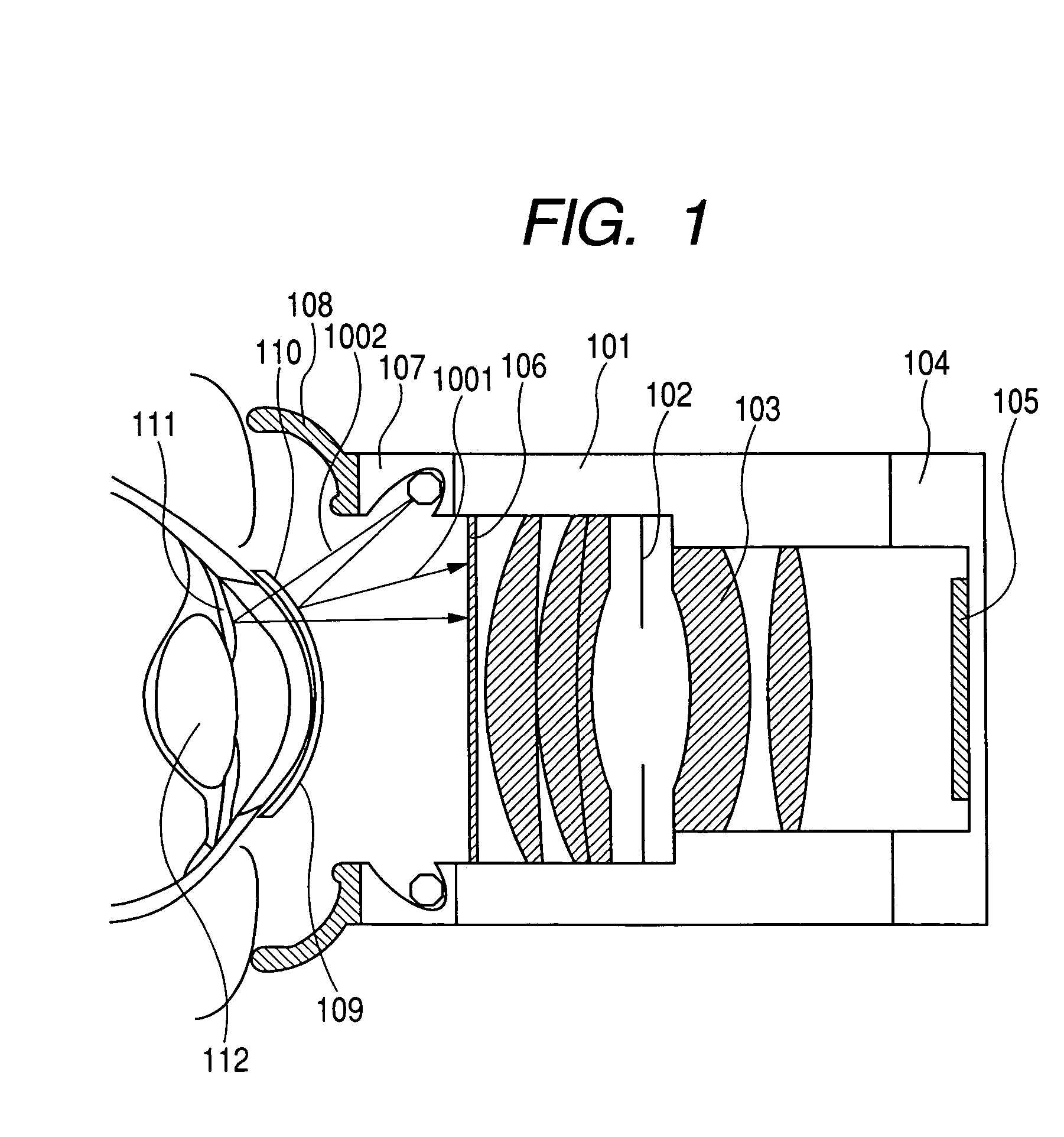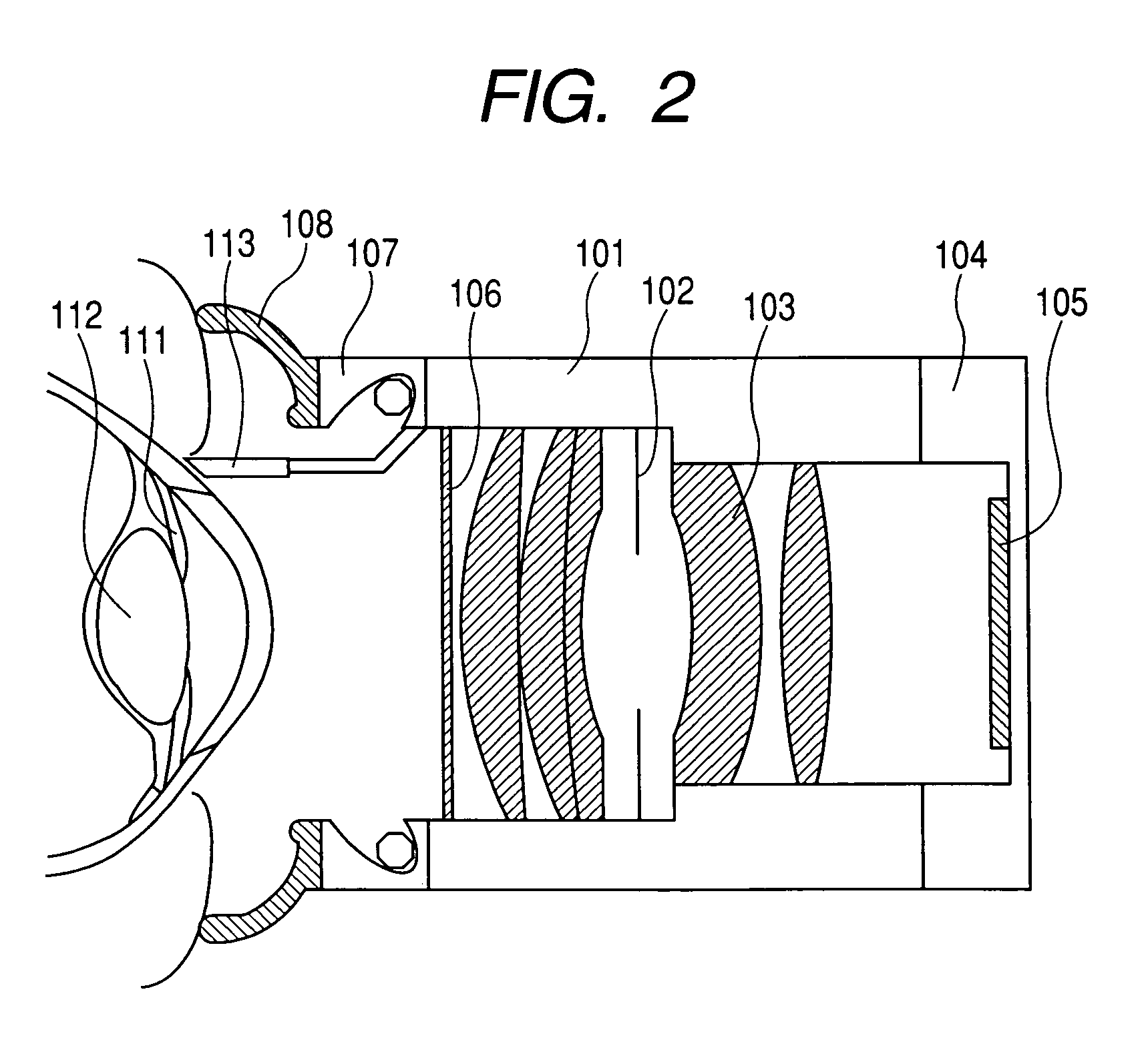Detection apparatus for detecting an amount of an object of analysis in a fluid present in an eye or on an eye surface
a technology of detection apparatus and analysis object, which is applied in the direction of instruments, applications, person identification, etc., can solve the problems of individual mismatch, inability to detect the amount of analysis object, etc., and achieve the effect of ophthalmic data management, and reducing the number of errors in input operations
- Summary
- Abstract
- Description
- Claims
- Application Information
AI Technical Summary
Benefits of technology
Problems solved by technology
Method used
Image
Examples
example 1
[0056]A detection apparatus of the present invention in an example 1 will be explained with reference to the accompanying drawings.
[0057]FIG. 1 is a cross-sectional view of the detection apparatus of the invention at use. In FIG. 1, there are shown a lens barrel 101 supporting the optical system of the detection apparatus; a diaphragm 102 for regulating a light amount entering an image pickup device 105; an imaging lens 103; a casing 104 for supporting the image pickup device 105; a protective glass 106 for protecting the imaging lens 103; an illuminating light source 107 to be used for image pickup; and a light-shielding eye cup 108 for avoiding an external light. On the side of a tested subject person, there are shown a sensor element 110 of a contact lens shape to be employed in the present detection apparatus; an iris 111 of the tested person; and an eye lens 112.
[0058]FIG. 3 is a front view of the sensor element 110. In FIG. 3, there are shown a sensor element 201 of a contact ...
example 2
[0090]A detection apparatus of the present invention in an example 2 will be explained with reference to FIG. 2. FIG. 2 is a cross-sectional view of the detection apparatus of the present example at use. In FIG. 2, there are shown a lens barrel 101 supporting the optical system of the detection apparatus; a diaphragm 102 for regulating a light amount entering an image pickup device; an imaging lens 103; a casing 104 for supporting an image pickup device 105; a protective glass 106 for protecting the imaging lens 103; an illuminating light source 107 to be used for image pickup; and an electrode probe 113 for detecting an amount of an object substance of detection in tear fluid of a subject person for test. In case the object substance of detection is glucose, the electrode probe is preferably an enzyme electrode utilizing glucose oxidase or glucose dehydrogenase.
[0091]There is also provided a light-shielding eye cup 108 for avoiding an external light. On the side of an tested subjec...
example 3
[0109]An example 3 shows a case where the detection apparatus of the example 1 is used in a network connection. A detection apparatus has a cross section similar to that of the example 1, as shown in FIG. 1.
[0110]Also the block diagram of the detection apparatus is same as that shown in FIG. 4. A configuration in case of a network connection is shown in FIG. 6. The configurations shown in FIGS. 1 and 4 will not be repeated as they are already explained in the example 1. In the following, there will be explained the configuration shown in FIG. 6. In FIG. 6, there are shown a detection apparatus 401 employed in the present example; an eyeball 402 of the subject person of test; and a network 403 employed for communication. In FIG. 6, the detection apparatus is directly connected to the network, but it may be connected thereto through a telephone line or the like. There are also provided a management server 404, having a product lot database 408, for managing the error data among the pr...
PUM
 Login to View More
Login to View More Abstract
Description
Claims
Application Information
 Login to View More
Login to View More - R&D
- Intellectual Property
- Life Sciences
- Materials
- Tech Scout
- Unparalleled Data Quality
- Higher Quality Content
- 60% Fewer Hallucinations
Browse by: Latest US Patents, China's latest patents, Technical Efficacy Thesaurus, Application Domain, Technology Topic, Popular Technical Reports.
© 2025 PatSnap. All rights reserved.Legal|Privacy policy|Modern Slavery Act Transparency Statement|Sitemap|About US| Contact US: help@patsnap.com



